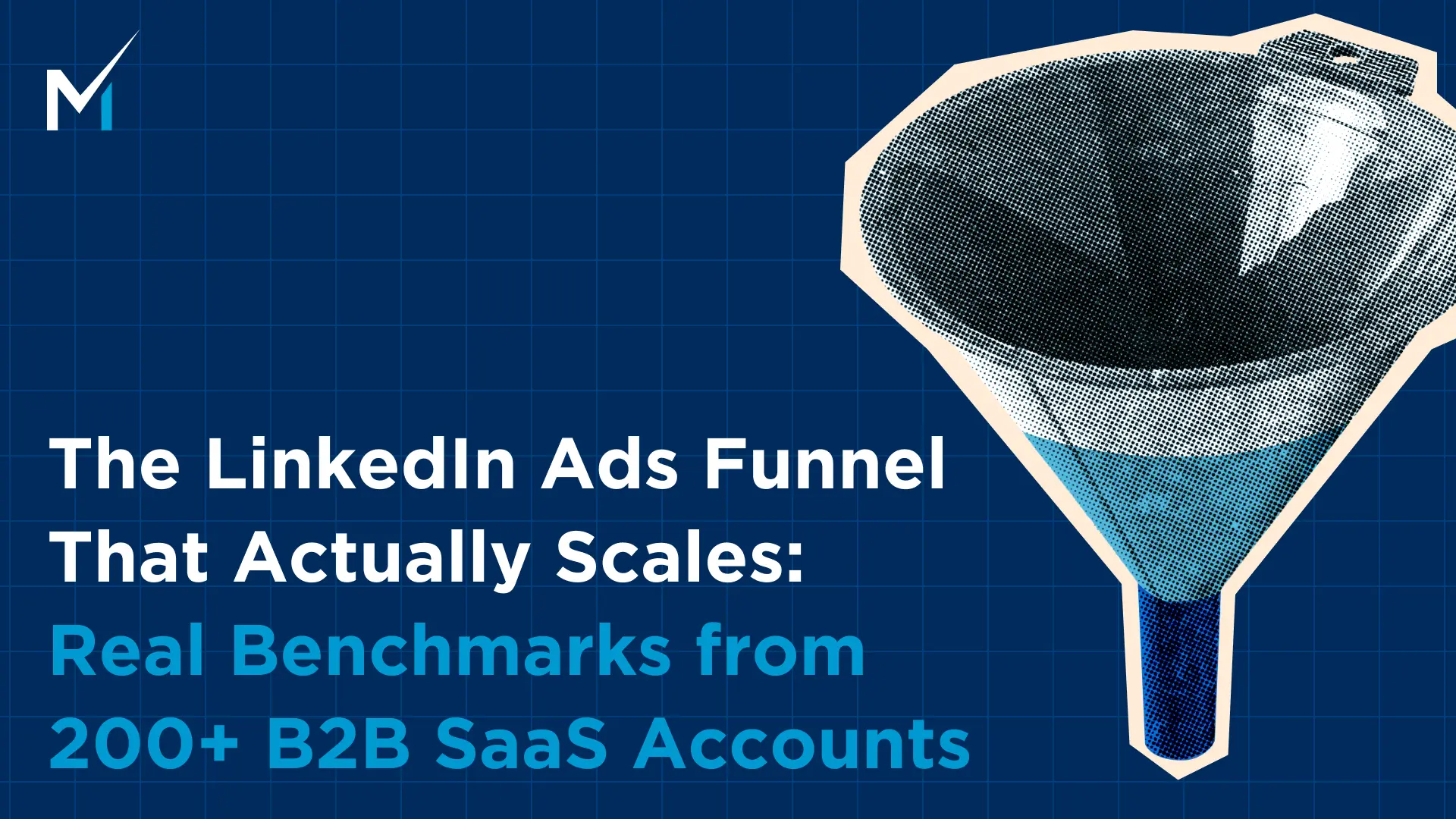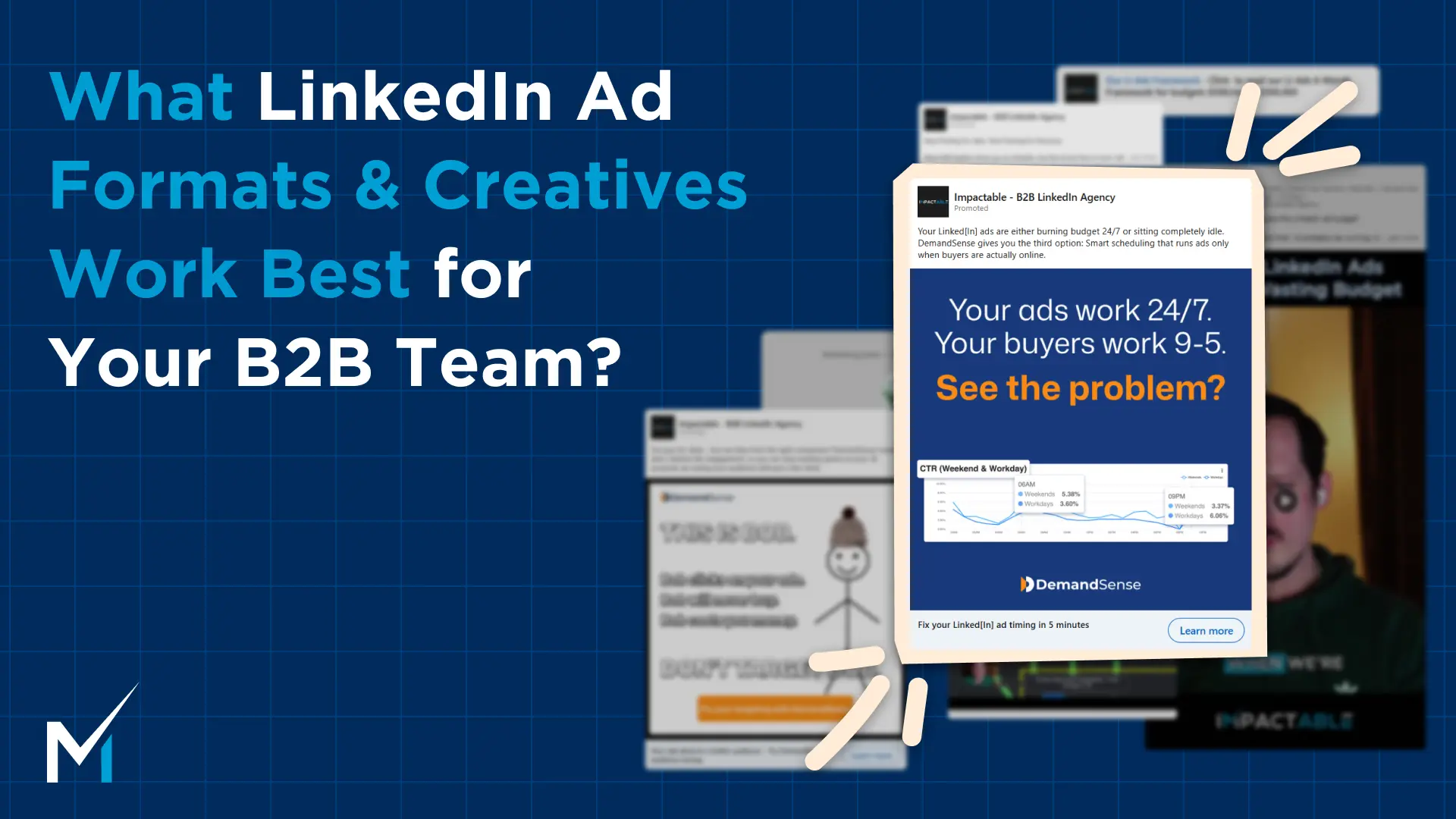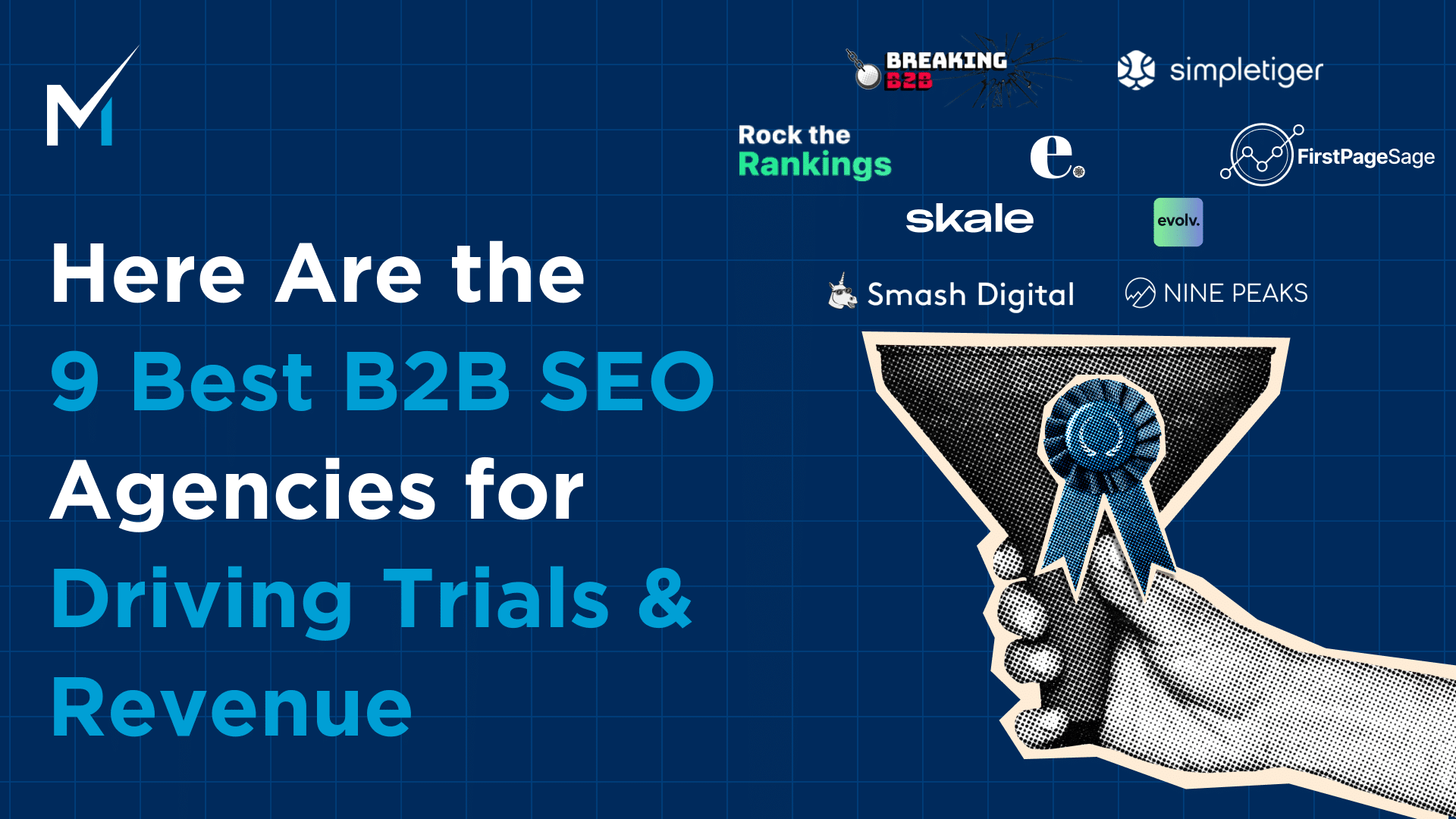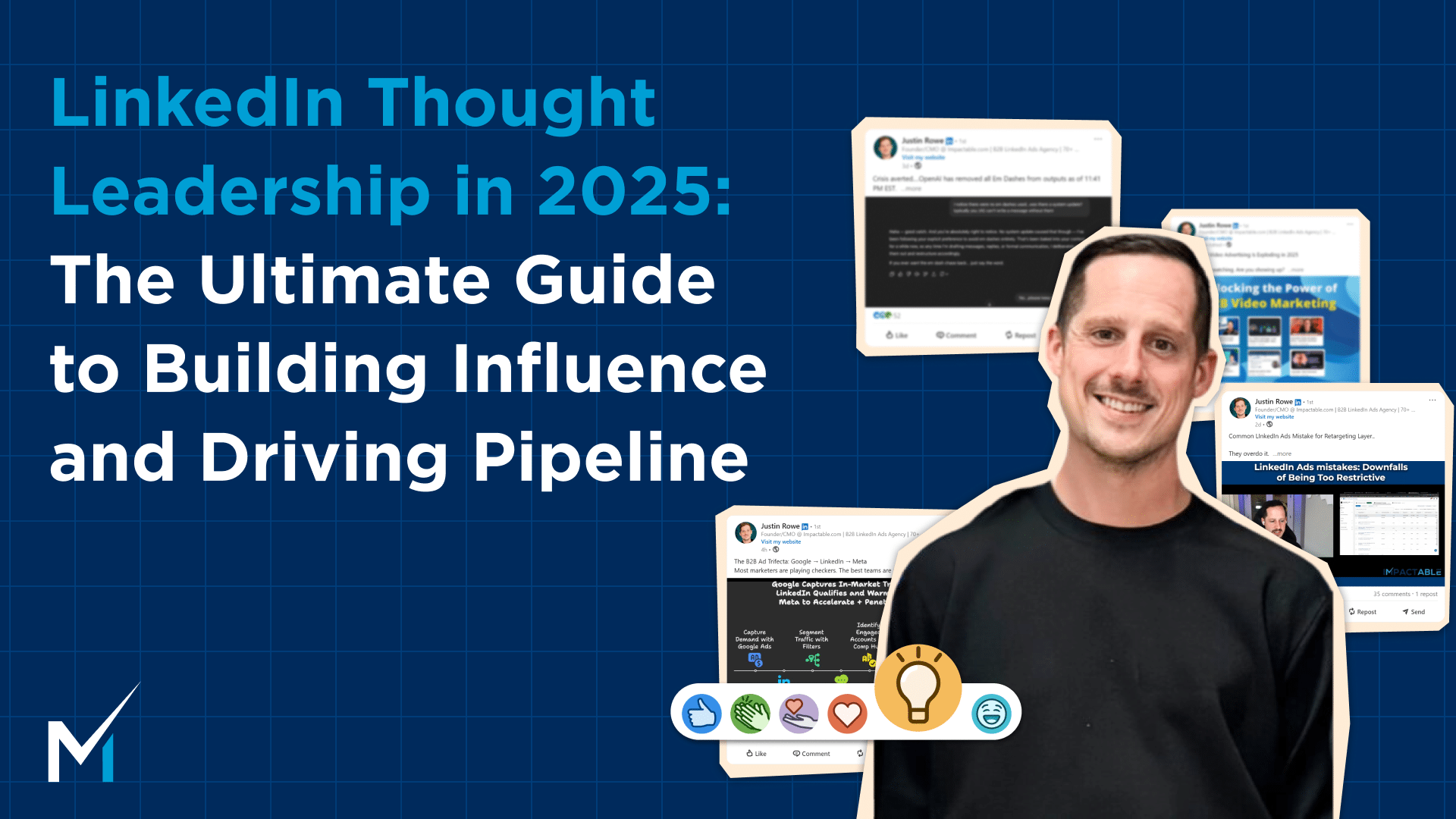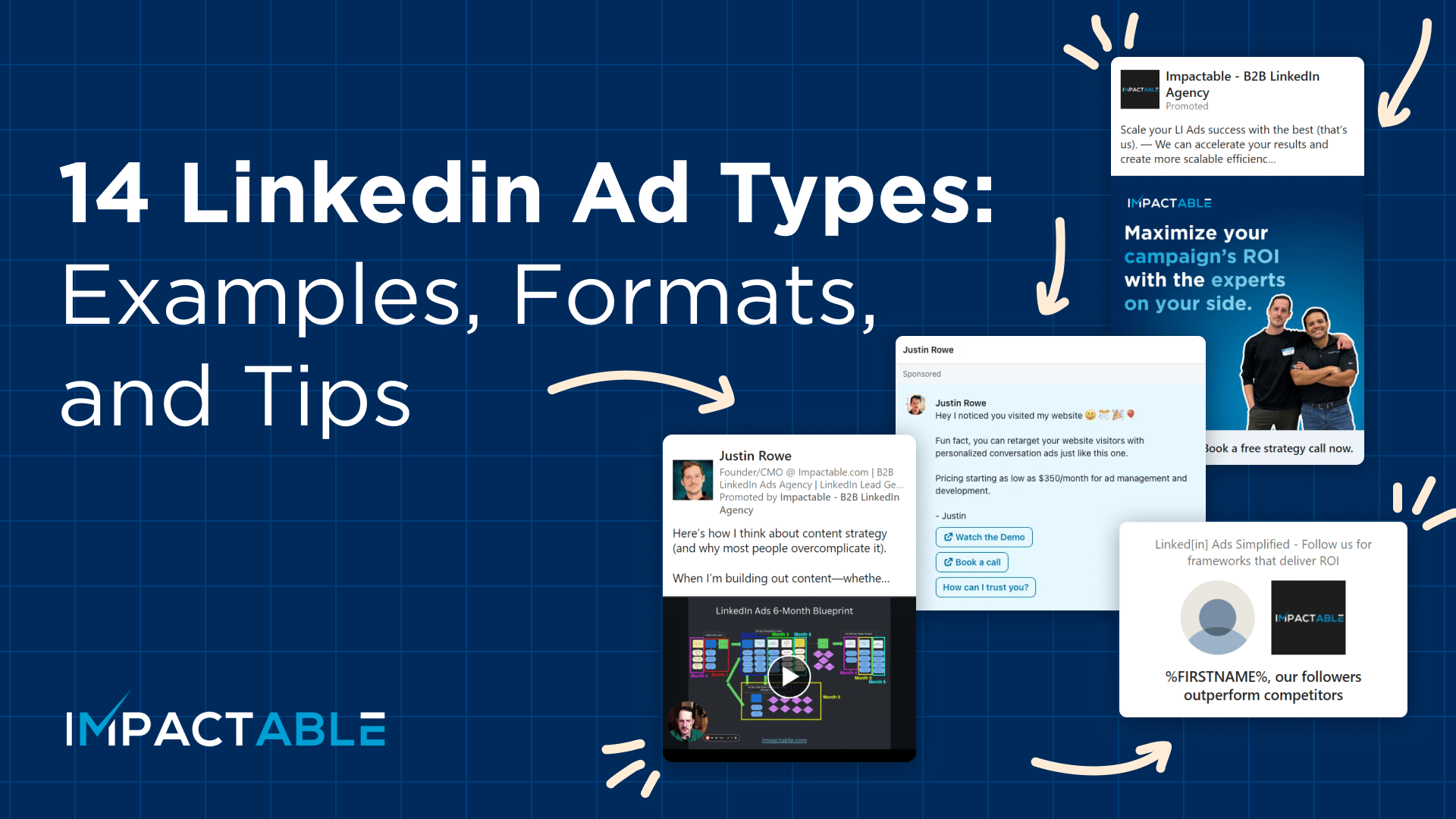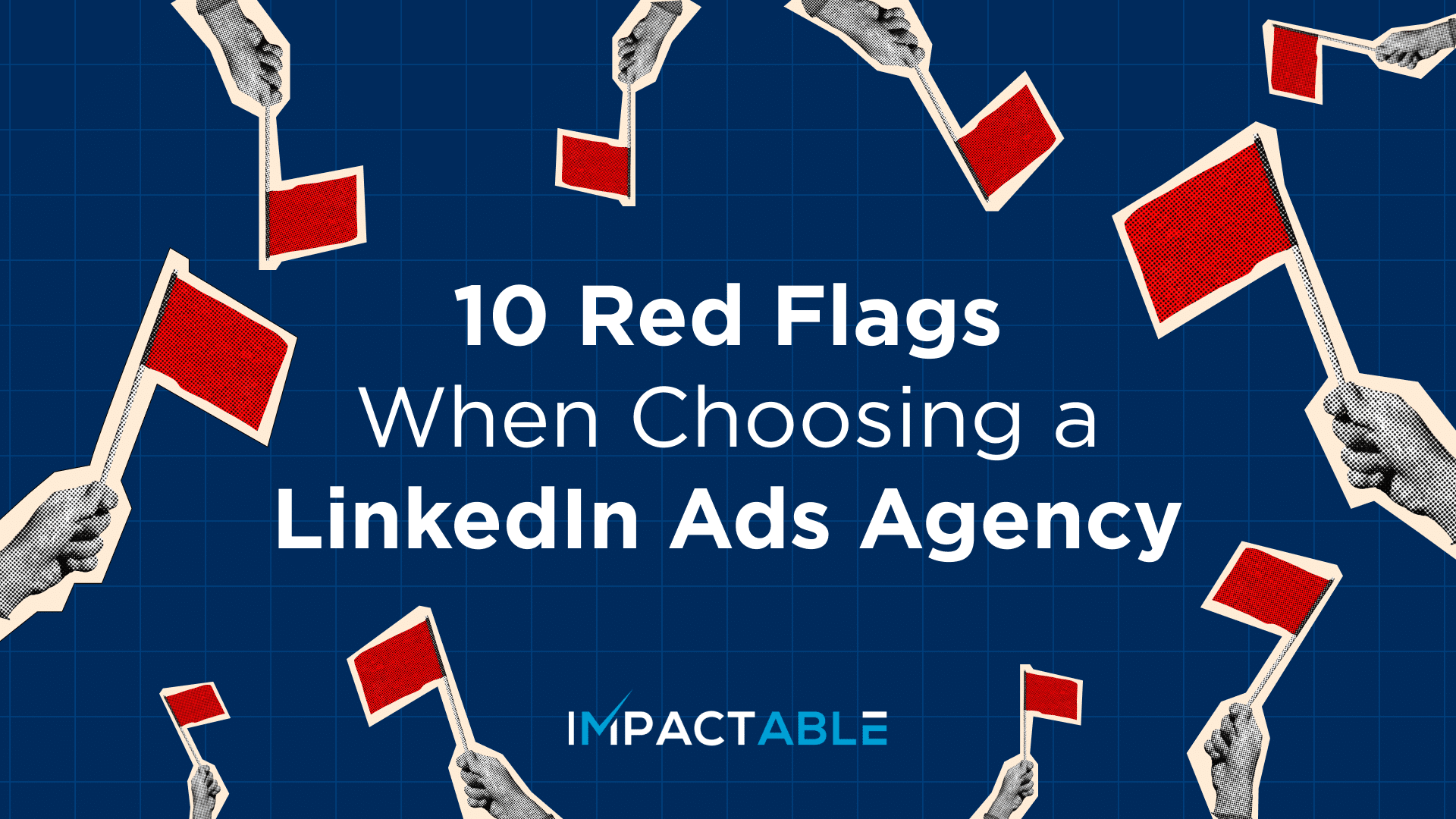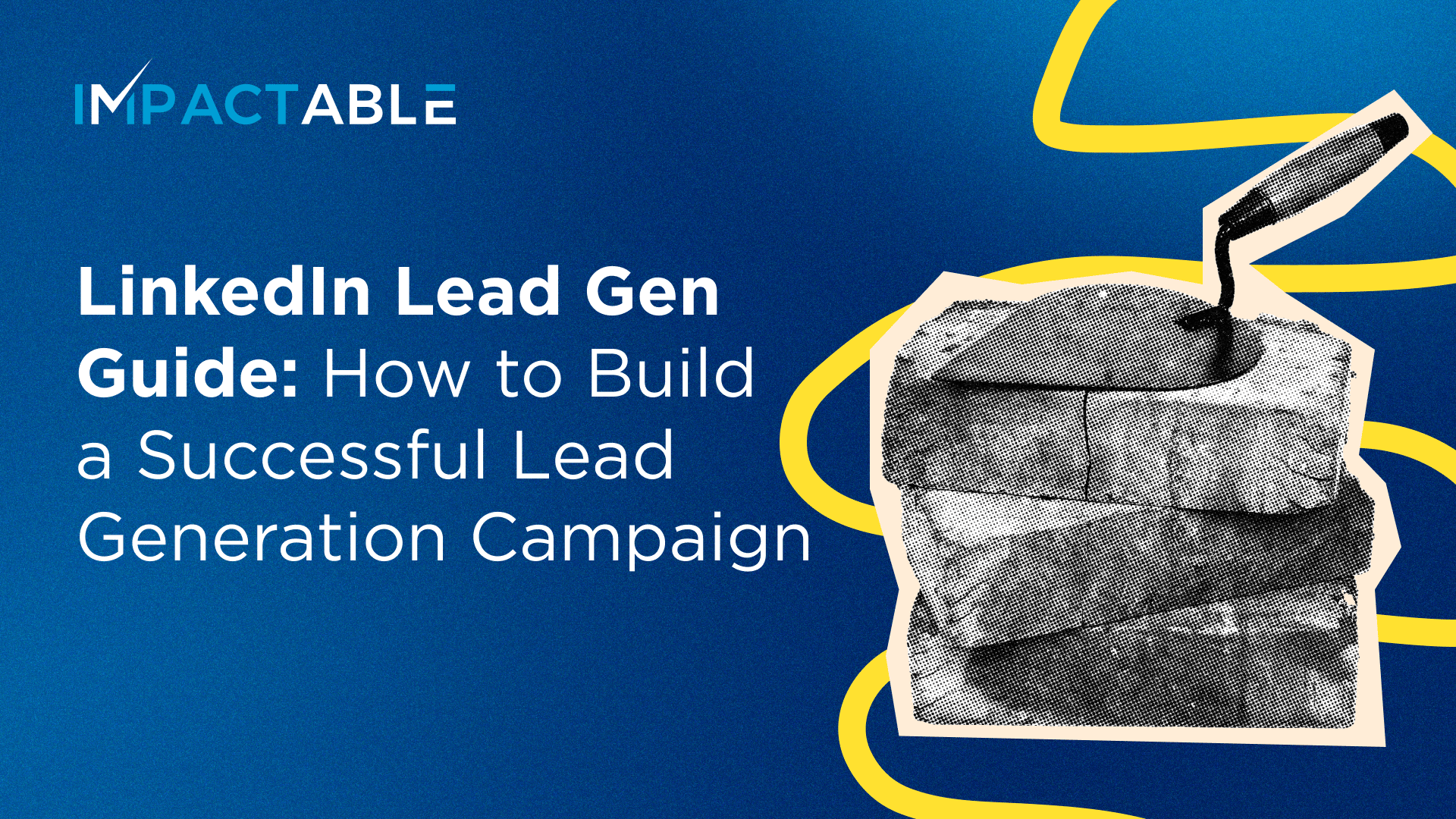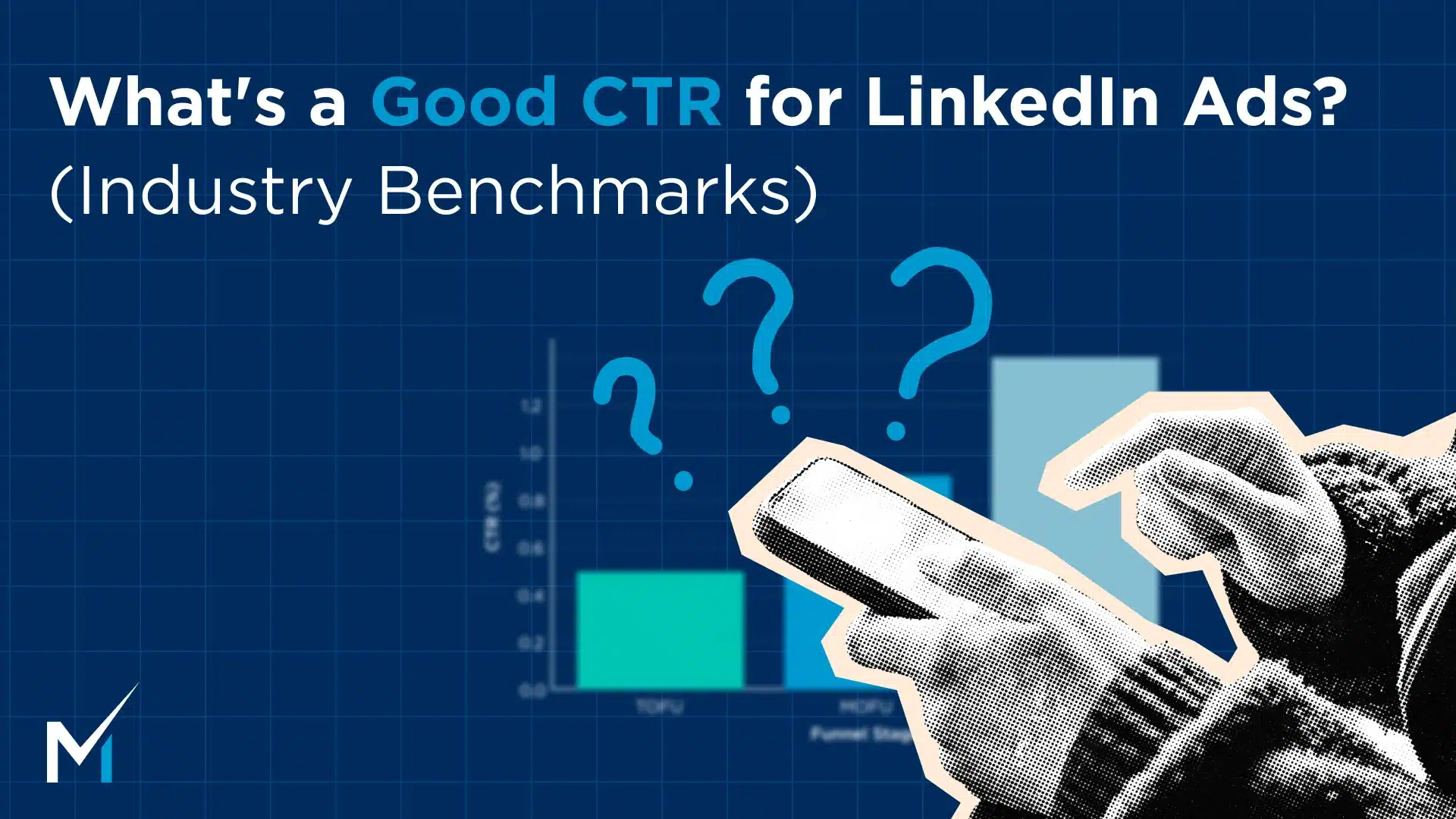I would like to start with a more foundational insight into our philosophy on Google search strategy, covering what Google paid search is, which search terms are ideal targets, and how integrating paid search with LinkedIn retargeting can enhance your ROI.
What is Google Search?
If you go to Google and type in anything, that is a Google Search. The results page follows a certain logic. Almost always, the top half of the page will be paid sponsored spots that companies pay for to appear around the specific keywords or phrases you typed in.
For example, if someone types in “LinkedIn Ads Agency” or “B2B LinkedIn Ads Agency,” Impactable (our agency) pays to show up in those top-of-page results. It’s beneficial because if someone’s searching for exactly what you offer, you want to appear on page one and step in front of that prime traffic. The fastest way to achieve this is to sponsor those keywords through Google Search ads.
The next half of the page is a mix of organic and paid results. The more long-term but harder way to appear here is through building up your SEO (search engine optimization). This involves creating blog articles geared around those keywords to build your domain trust and organically rank for those terms.
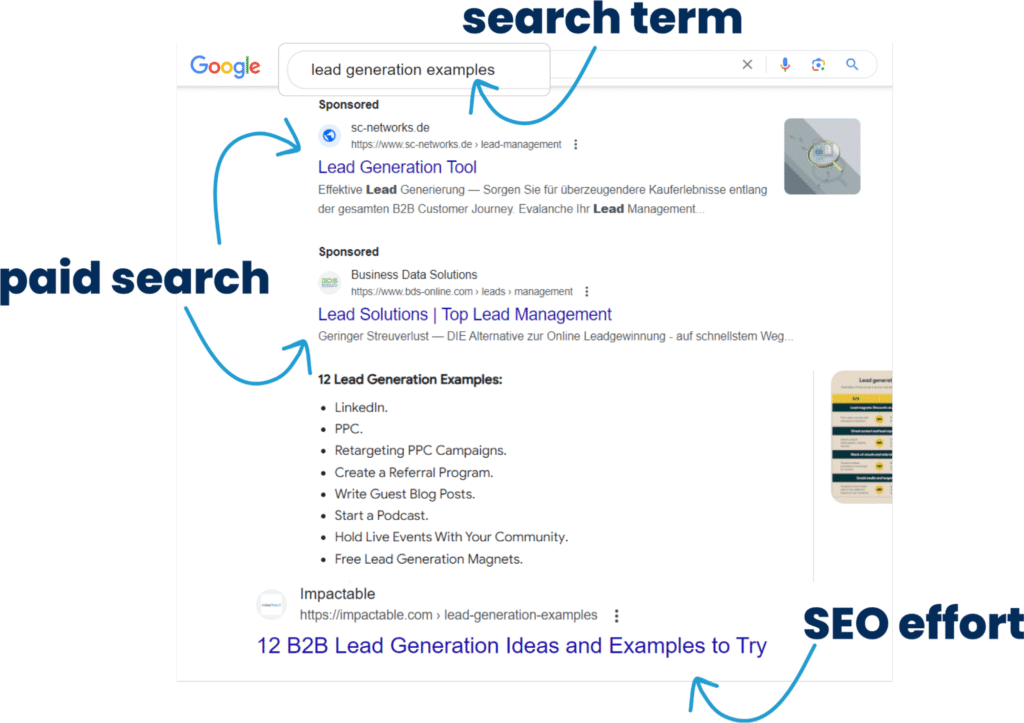
How Google Search Ads Work
Google Search is a way to secure the top ranking spots because those are always going to be paid positions, guaranteeing your share of the traffic. This allows you to achieve visibility much faster compared to SEO, which requires a significant amount of time, energy, and momentum. It could take 6-12 months to rank on page 1 organically through SEO, and in highly competitive arenas…you might never achieve page 1 results on top intent terms.
Sometimes, there are competitors who have been investing in SEO for years on the terms you’re trying to rank for, making it difficult or even impossible to achieve a reasonable rank in a short period.
With Google Search ads, you can pay to appear in front of specific targeted searches that are no-brainer investments. However, the control you have over targeting is different from that of platforms like LinkedIn. On LinkedIn, you can specify exact job titles, industries, and company sizes for your ads to appear. Google Search ads, on the other hand, are primarily based on the keywords and phrases people are searching for.
Types of Search Matches to Go For
When deciding what phrases and searches you want to show up for, there are three main types of search matches to consider:
1. Exact Match
With exact match, you specify that the search term has to be exactly “B2B LinkedIn ads agency” and not variations like “best B2B LinkedIn ads agency” or “worse B2B LinkedIn ads agency.” It has to be this exact phrase you choose.
Although it can include minor variations, it focuses on the specific phrase. For example, if someone searches for “LinkedIn ads agency,” it’s different from searches like “What is a LinkedIn ads agency?” or “Local LinkedIn ads agencies.” There are many variations of searches that might not align with your exact match criteria.
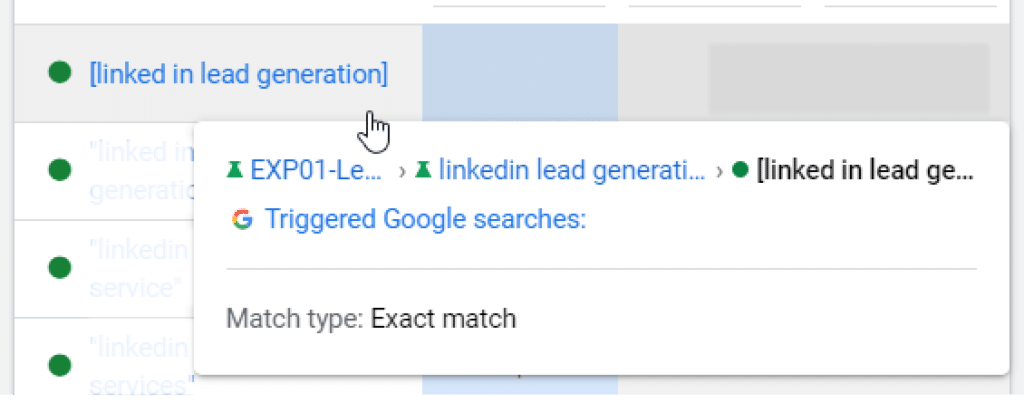
2. Phrase Match
With phrase match, you can bid on a phrase like “LinkedIn ads agency,” and it will include various combinations such as “best LinkedIn ads agency for software companies,” “worst LinkedIn ads agency for retail,” and “LinkedIn ads agencies for IT service companies.” This is beneficial because it covers a wide range of potential searches without needing to list every variation.
Often, marketers start with phrase matches and refine over time. By analyzing which specific searches result in actual booked calls, you can add those successful searches to your exact match list. Phrase matching allows you to discover and focus on the most effective keywords.
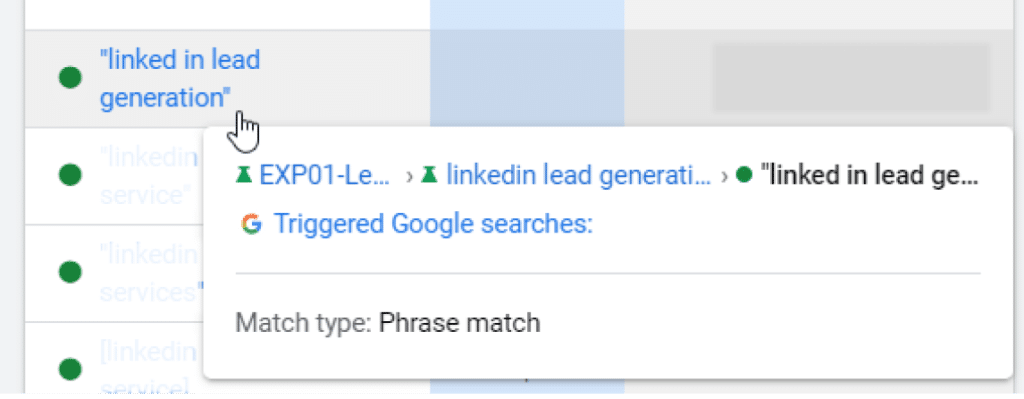
Additionally, you’ll identify searches to exclude. For example, if you frequently pay for clicks from searches like “I would never use a LinkedIn ads agency,” which don’t result in meaningful conversations, you can add those terms to your exclusion list to avoid wasting money on irrelevant clicks.
3. Broad Match
The third type is a broad match, where you target a general term like “LinkedIn ads agency,” giving Google the flexibility to show your ad for searches that are loosely related, such as “LinkedIn agency” or “agency that uses LinkedIn ads.” This can result in your ads appearing for a wide range of searches that may not be highly relevant.
Broad match is typically not recommended because it often leads to less targeted traffic and higher costs without corresponding results. Instead, phrase matching is more effective. By researching search volumes and curating a comprehensive list of targeted exact phrases, you can better control your ad spend and improve the quality of your traffic.
How to Choose Phrases and Searches to Show Up For
When developing your strategy for selecting which phrases and searches to target, consider categorizing them into three main buckets:
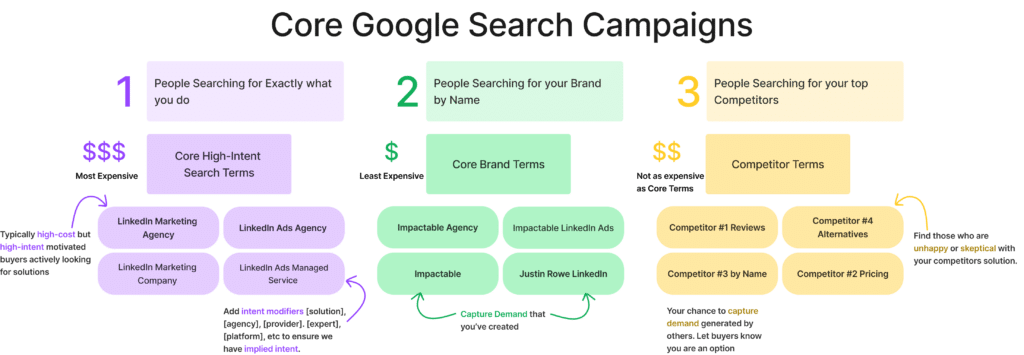
Group 1: Brand Campaigns
1. Brand Campaign
Ensure you show up when people search for your company name or brand-specific terms. This helps protect your brand and capture high-intent traffic.
Should You Bid on Your Brand Name in Google Ads?
There’s considerable debate over whether you should run a paid Google search campaign for your branded terms. Here’s how to decide:
- If You’re Organically Ranking #1 and Have No Competitors Bidding on Your Name: You might skip the paid brand campaign. If you already dominate the organic search results for your brand name and its variations, and there are no competitors targeting your brand with ads, you can likely rely on organic traffic alone.
- If You’re Not Organically #1 or Have Competitors Bidding on Your Brand Name: You should definitely have a paid brand campaign. This ensures that competitors don’t steal your traffic and helps maintain your visibility. Paid brand campaigns guarantee that you remain at the top of the search results, safeguarding your brand presence.
Competitor campaigns are a viable strategy for capturing relevant traffic, and you want to ensure you’re not losing potential customers to these tactics. Hence, maintaining a brand campaign can be essential in these scenarios.
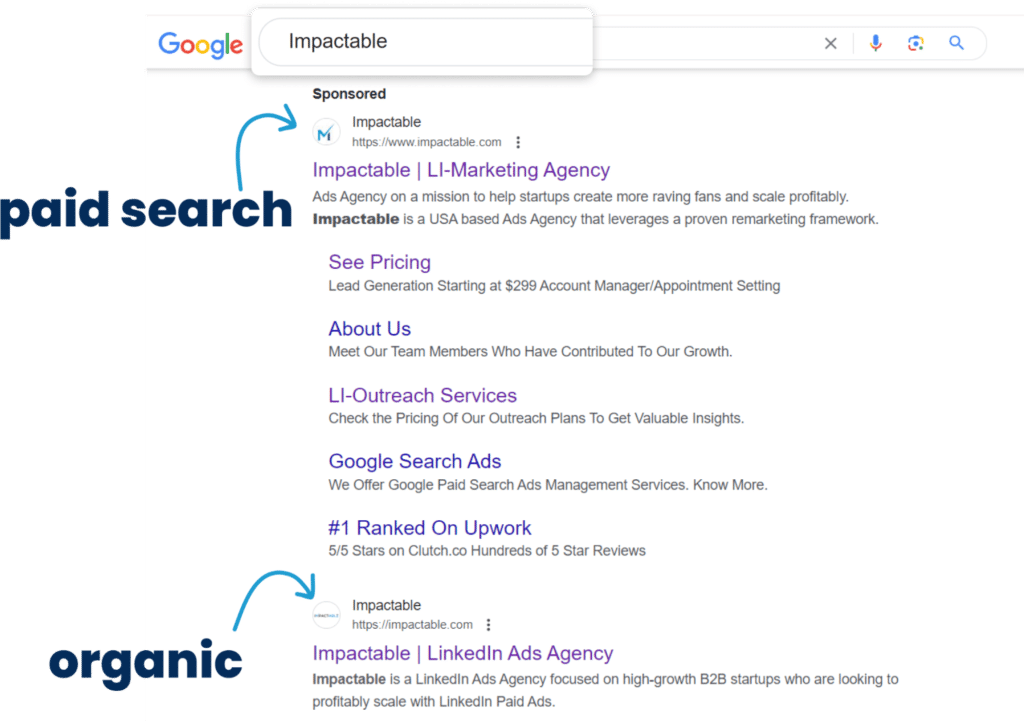
Group 2: Core, Middle-Intent, and Broad Research Terms (Hard to define the intent)
1. Core High-Intent Search Terms
The second category, which is crucial, comprises your core high-intensity search terms. These are the queries where searchers are looking for precisely what you offer, making it imperative for you to appear in their search results.
For us, these terms include “LinkedIn ads agency,” “B2B LinkedIn ads agency,” “LinkedIn ads managed services,” and “company to run LinkedIn ads.” Missing out on visibility for these terms means overlooking significant opportunities.
While targeting these core terms can be costly and requires ongoing optimization to filter out irrelevant clicks, it’s essential to assess their search volume. Sometimes, despite curating a list of top core searches, the search volume might not justify the investment, leading to minimal returns on your Google Ads expenditure.
2. Middle Intent Search Terms
Moving beyond your core high-intent terms, you’ll encounter search queries that reside in the middle ground of intent. These terms often leave room for interpretation—are searchers merely seeking information, or are they genuinely interested in your services?
For instance, queries like “LinkedIn campaign manager” or “LinkedIn paid ads” fall into this category. While they signal an interest in a solution, they may not explicitly indicate readiness to make a purchase. Engaging with these middle intent terms can be beneficial, offering opportunities to capture prospects who are in the research phase or nearing a decision.
3. Broad Research Terms
These terms are less specific and can capture a wide range of searches. For example, these can be any variations of the term “LinkedIn”, like “what is LinkedIn ads”, “what is the cost of LinkedIn ads”, that could be just anything.
While they may include more research-oriented queries, they can also help you identify emerging trends and interests in your market.
Group 3: Competitor campaigns
And then the third group would be bidding on competitor campaigns. Competitor campaigns involve bidding on the keywords associated with competitors’ names or brands. For instance, when users search for our friend AJ Wilcox, it presents us with an opportunity to prominently feature the Impactable brand above his name or his company.
While some might view this strategy as shady, I see it as standard practice in paid search. The premise behind competitor ads is that when users search for your competitor, they are likely aware of the problem and potential solutions. Your competitor has essentially educated the prospect, and by positioning ourselves in front of their traffic, we aim to intercept some of their demand before they commit elsewhere.
This approach, in my view, is fair game, as it capitalizes on existing market awareness and redirects traffic toward our offerings. Notably, even industry giants like LinkedIn participate in such practices; a search for “Impactable” typically yields a LinkedIn ads promotion on page one. This suggests that LinkedIn likely maintains a list of all providers managing LinkedIn ads, endeavoring to redirect more traffic to their company compared to local providers.

Integrating Google Ads with LinkedIn Ads
The integration of Google Ads with LinkedIn Ads presents a strategic approach to optimize marketing ROI. Here’s how it unfolds:
Google Ads can indeed incur significant costs, particularly with core, middle-intent, and broad search terms consuming a substantial portion of the budget. Core high-intent search terms, for instance, may cost $30-70 per click, leading to concerns about budget sustainability and ROI viability.
However, from the perspective of running a LinkedIn ads agency, I still believe that paid search and SEO are foundational layers of almost any marketing ecosystem. These channels target traffic that has already progressed along the buyer journey, possessing a heightened awareness of their needs and potential solutions.
When users search for terms like “LinkedIn ads agency,” they are already in the consideration phase, actively seeking a solution. This places them further down the buyer journey, often resulting in quicker decision-making and conversion. With a shorter buying cycle, Google Ads offer a highly transactional medium to capture ready-to-act prospects and facilitate conversions.
Why is retargeting paid search clicks on LinkedIn important?
Now, in my mind, one of the ways that you can kind of hedge your bet is I am much more willing to pay $30, $40, $50 for a click for someone that says “B2B LinkedIn ads agency for IT service company”, if two things are true:
- If I think that our company is best positioned to actually satisfy the needs of whoever is searching for that,
- if I have a good retargeting ecosystem that can convert that traffic on the back end
If, for example, our friend AJ Wilcox or any competitor are running Google ads, and if we both are bidding for those terms, maybe that prospect visits both of us, and we both shall out $30 for that click. If neither one of us are retargeting, then it comes down to who had the better landing page, who could inspire more trust and confidence on your website, and that becomes the determining factor, because that’s all you got – that first click, their impression, and what you could do with your website to kind of change their mind. Then they go back the next 30-40 days they’re thinking on it, and then they’ll book a call, and maybe you’ll have that extra touchpoint, and then that’s it.
Now, if you have re-targeting in place, you get to continue the conversation over the next 30 to 90 days, and you get to continue to input.
So in my mind, that’s a big game changer, because most people that I talk to are not satisfied with their website. They think that it could have more trust factors built in, it doesn’t convey their personality, and it doesn’t really show all their expertise.
So if prospects leave the Impactable website, after searching for “B2B LinkedIn ad agency”, guaranteed, if they’re watching TV, if they’re on the internet, if they’re on Facebook or if they’re on LinkedIn, they’re going to see more content about Impactable over the next 90 days.

And that gives us a massive unfair advantage over competitors who do not have that in place. Because over the next 90 days, instead of it just being up to the buyer with no additional information, we are continuing the conversation. We are curating assets that shed us in a much more professional and expert kind of way to the point where, over the next 90 days, we are able to tip the skills in our favor more often than not against our competitors.
And it gives us an absolute unfair advantage – it improves the ROI of Google ads, but then it also helps improve the ROI of LinkedIn, because part of LinkedIn’s value is that it’s helping convert traffic from other high quality sources, then it takes some of the pressure off of LinkedIn to have to generate all this revenue and book calls all by itself without any help.
So it’s beneficial for Google, it’s beneficial for LinkedIn ads, of course it’s beneficial for the company that’s actually leveraging this marketing ecosystem.
Creating a Multichannel Marketing Ecosystem
In my view, the essence lies in creating a marketing ecosystem, not just focusing on improving individual channels like Google ads or LinkedIn ads, although enhancing each is essential. By integrating these channels, you can improve the performance of both simultaneously.
Similarly, incorporating Meta, Programmatic, LinkedIn outreach nurture, and email touch shouldn’t be seen as separate entities. When these channels target the same audience or share overlapping elements, each additional layer added should contribute to enhancing the overall ROI.
Final Thoughts
In today’s landscape, where budgets are tightening, competition is fierce, and companies are vying for attention, nurturing a robust multichannel marketing ecosystem can offer a significant competitive edge. This advantage is particularly impactful for small, scrappy startups seeking to outmaneuver larger competitors and punch above their weight class in the startup world.




